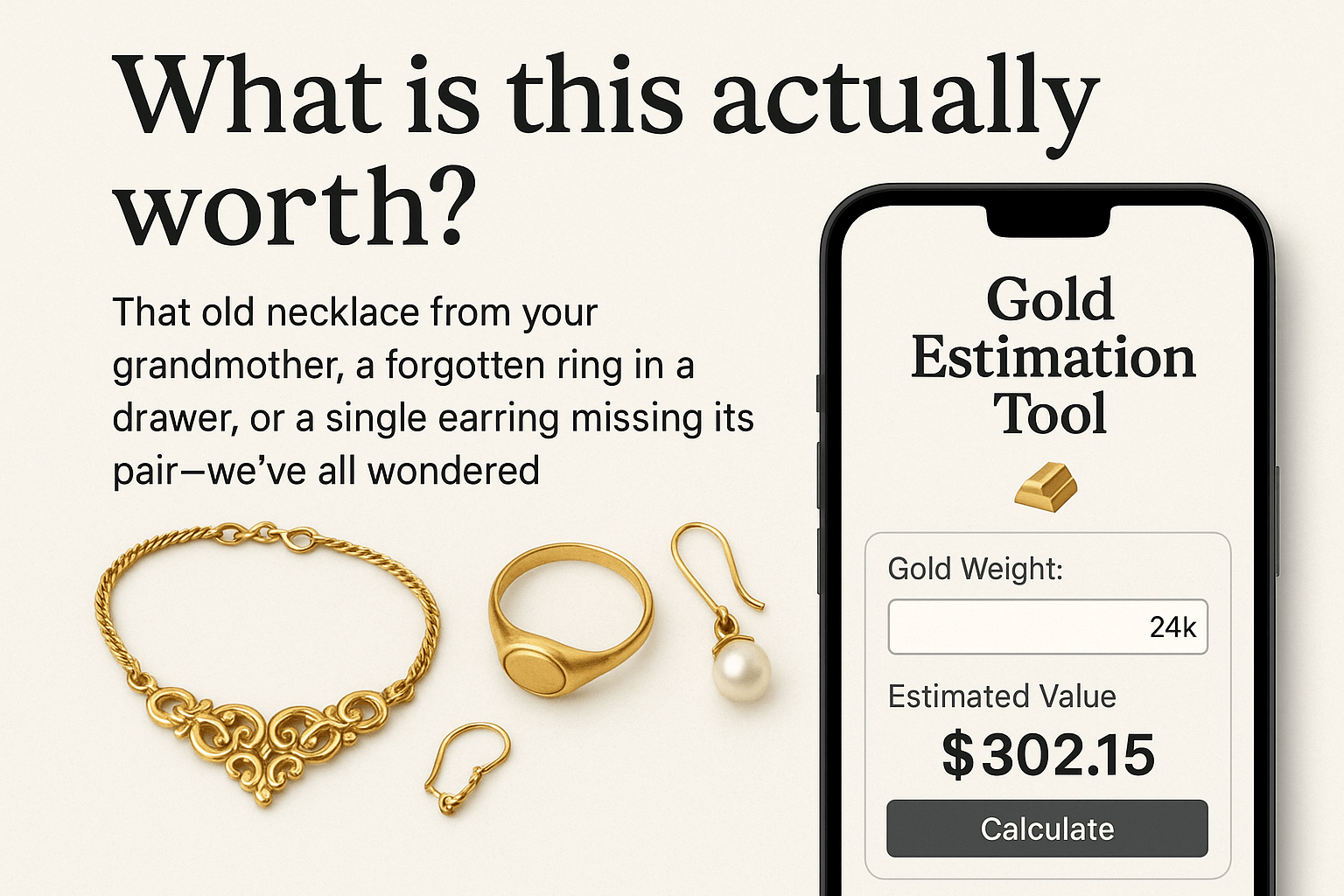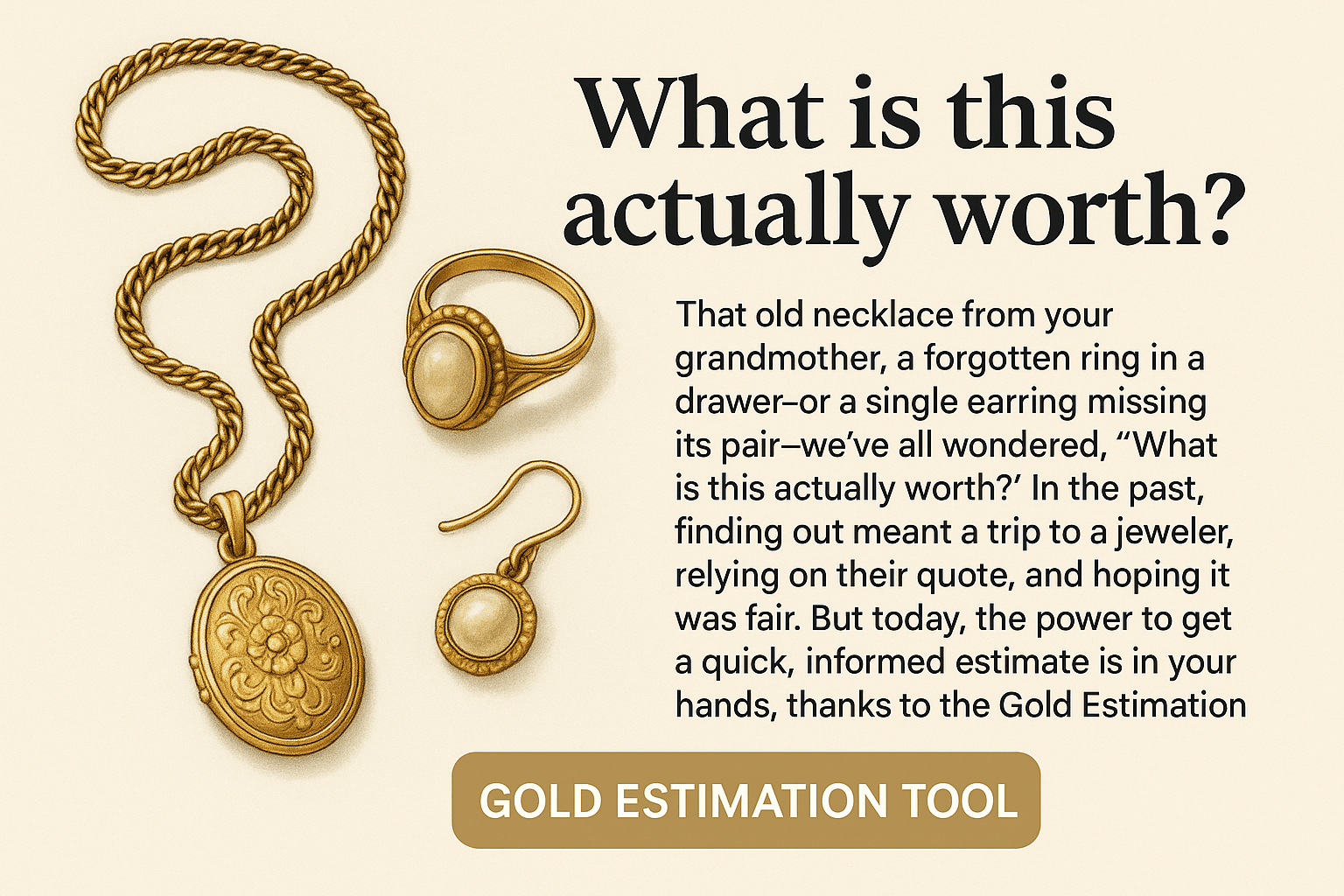That old necklace from your grandmother, a forgotten ring in a drawer, or a single (Gold Estimation Tool) earring missing its pair—we’ve all wondered, “What is this actually worth?” In the past, finding out meant a trip to a jeweler, relying on their quote, and hoping it was fair. But today, the power to get a quick, informed estimate is in your hands, thanks to the Gold Estimation Tool.
This comprehensive guide will demystify these digital calculators. We’ll explore how they work, their incredible benefits, their limitations, and how you can use them to become a savvy seller or a confident buyer.
What Exactly is a Gold Estimation Tool?
A Gold Estimation Tool is an online calculator, often found on websites of jewellers, pawnbrokers, bullion dealers, and refiners, that provides a quick price calculation for your gold items based on a few key inputs.
Think of it as a digital scale that doesn’t just weigh your gold, but also understands its purity and the ever-changing tides of the global market. It’s designed to give you a baseline value, empowering you with knowledge before you ever step foot in a store or negotiate a sale online.

How Does a Gold Estimation Tool Work? The Magic Behind the Math
The “magic” is really a straightforward formula based on the fundamental principles of the gold market. Here’s a breakdown of the process and the key variables involved.
1. The Core Inputs You Provide
Any reliable tool will ask for three critical pieces of information:
-
Weight: This is the most obvious factor. You need an accurate weight, preferably in grams or troy ounces. A small digital kitchen or jewellery scale is a cheap and invaluable tool for this.
-
Purity (Karat): This indicates how much of the item is actually gold versus other alloy metals. Pure gold is 24 karats (24k), but it’s too soft for everyday jewellery. Common purities include:
-
10k: 41.7% gold
-
14k: 58.3% gold
-
18k: 75% gold
-
22k: 91.7% gold
-
24k: 99.9% gold
The karat is usually stamped on the item (e.g., “14k,” “585,” “750”).
-
-
Type of Gold: Some tools may ask you to specify if it’s jewellery, a coin, or a bar. This can sometimes affect the final estimate, as coins from government mints often carry a premium over their pure gold value.
2. The Invisible (But Crucial) Input: The Live Gold Spot Price
This is the engine of the tool. The Gold Estimation Tool is connected to live financial markets and pulls the current spot price of gold. This is the global benchmark price for one troy ounce of pure (99.99%) gold. It fluctuates constantly throughout the trading day based on global supply, demand, currency values, and economic factors.
3. The Calculation: Crunching the Numbers
Once you input your data, the tool performs a standardized calculation:
-
Convert Weight to Troy Ounces: Since the spot price is per troy ounce, your weight (often in grams) is converted. (1 troy ounce = 31.1035 grams).
-
Calculate Pure Gold Content: It multiplies the weight by the purity percentage. For example, 10 grams of 14k gold contains
10 grams * 0.583 = 5.83 gramsof pure gold. -
Apply the Spot Price: It calculates the raw melt value by multiplying the amount of pure gold by the current spot price.
Simple Example:
-
Item: A 14k gold ring
-
Weight: 10 grams
-
Spot Price: $2,000 per troy ounce
-
Calculation:
-
Pure Gold Content:
10g * 0.583 = 5.83g -
Convert grams to troy ounces:
5.83g / 31.1035 = 0.187 tr oz -
Raw Value:
0.187 tr oz * $2,000 = $374
-
So, the quick price calculation from the tool would be approximately $374.
The Critical Difference Between Melt Value and Final Offer
This is the most important concept to understand. The figure from a Gold Estimation Tool is almost always the melt value or intrinsic bullion value. It is the absolute baseline.
A buyer (jeweller, refiner, pawn shop) needs to make a profit and cover their costs. Therefore, their actual offer will be less than the melt value. This difference is known as the “buy-back” or “refiner’s” margin. A fair offer typically ranges from 70% to 90% of the melt value, depending on the buyer and the item type.
For unique, antique, or designer pieces, the value could be higher due to collectibility or craftsmanship, but this requires a professional appraisal, not an online tool.
Why Use a Gold Estimation Tool? The Unbeatable Benefits
-
Empowerment and Knowledge: You walk into a negotiation knowing the approximate intrinsic value of your item, preventing lowball offers.
-
Convenience and Speed: Get an estimate in seconds from the comfort of your home, 24/7.
-
Transparency: It demystifies the valuation process, showing you exactly how the value is derived.
-
Comparison Shopping: You can quickly get estimates from multiple online buyers to see who is offering the best percentage of the melt value.
Limitations and Words of Caution
A Gold Estimation Tool is a guide, not gospel. Keep these points in mind:
-
It Doesn’t See Your Item: It can’t account for gemstones, damage, brand name (e.g., Cartier, Tiffany), or artistic value. These can add significant value or, in the case of damage, subtract it.
-
The Final Offer is Lower: As discussed, the final cash offer will be less than the tool’s estimate.
-
Accuracy of Inputs: The estimate is only as good as the data you provide. An incorrect weight or misidentified karat will throw the calculation off entirely.

How to Get the Most Accurate Estimate
-
Weigh Accurately: Use a precise digital scale.
-
Identify Karat Correctly: Look for the stamp. If unsure, many jewellers will test it for free.
-
Use Reputable Tools: Rely on tools from established bullion dealers like APMEX or JM Bullion, or national refiners.
-
Understand it’s a Starting Point: Use the number as your baseline for negotiation, not your expected final sale price.
Frequently Asked Questions (FAQs)
Q: Is the value from a gold estimation tool what I will be paid?
A: Almost certainly not. The tool provides the melt value. Buyers will offer less than this (typically 70-90%) to cover their business costs and profit margin.
Q: My item is antique and has sentimental value. Will the tool account for that?
A: No. Sentimental value has no bearing on the intrinsic gold value. An online tool only calculates the value of the raw metal. For antiques, you may need a formal appraisal from a specialist.
Q: How often does the gold spot price change?
A: The spot price changes continuously throughout the global trading day, Monday through Friday. It’s influenced by currency markets, economic data, and geopolitical events.
Q: Should I use multiple estimation tools?
A: Yes, absolutely. This is a best practice. It not only helps you verify the calculated melt value but also allows you to see which companies might be offering better buy-back rates, saving you significant money.
Q: Does the tool work for gold-plated items?
A: No. Gold estimation tools are designed for solid gold items. Gold-plated jewellery has only a microscopic layer of gold over a base metal (like brass or copper) and has very little to no melt value.
Conclusion: A Powerful Tool in Your Pocket
The Gold Estimation Tool has revolutionized the way individuals interact with the gold market. It has shifted power from the expert behind the counter to the consumer with a smartphone. By providing a transparent, quick price calculation, it demystifies a once-opaque process and arms you with essential data.
While it doesn’t replace the final assessment of a reputable buyer for a firm offer, it ensures you begin that conversation from a position of knowledge, not guesswork. So, before you sell your gold, take a minute to use this powerful digital ally. It might just be the most valuable minute you spend.
Disclaimer: This article is for educational and informational purposes only and does not constitute financial or professional advice. The estimated values provided by any online tool are approximations only. The actual value you receive for your gold items may vary significantly based on the buyer, market conditions, and the specific characteristics of your item. We do not guarantee the accuracy of any third-party tools linked herein. If you have any concerns regarding the content of this post, please visit our DMCA page for guidance on content removal procedures.
